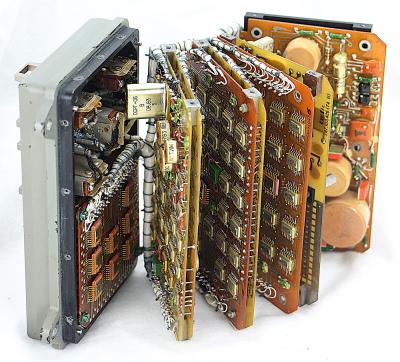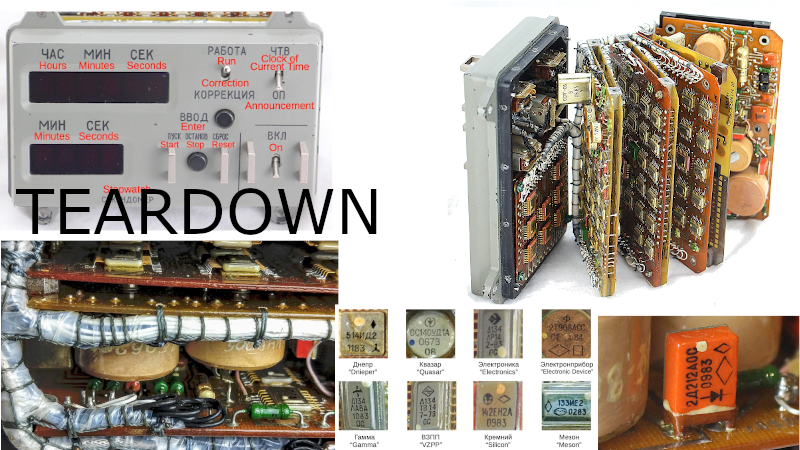We love spacecraft and we definitely love teardowns, especially if they are for vintage devices. [Ken Shirriff] writes about taking apart the digital clock module from the Soviet Soyuz series of spacecraft and there are a lot of interesting bits to the device. After all, it has been into space.
The Soyuz series of spacecraft made their maiden voyage in 1966, and are still flying today. The clock in question comes from somewhere in the middle, around 1996. On the outside, it seems like any spaceship gizmo, and the digital clock keeps local time along with a stopwatch and an alarm function. The guts are much more interesting with no less than 10 PCBs sandwiched inside the small enclosure.

The system consists of dual layer-boards with a mix of SMD and through-hole components that are interconnected by a series of wires that are bunched and packed to create a wiring harness. The pictures show a very clever way of setting up the stack and the system is serviceable by design as the bunch opens up like a book. This gives access to the unique looking components that include 14-pin flat pack chips, large ceramic multicoil inductors, green colored resistors, and orange rectangular diodes.
There are isolated PSU boards, control boards, clock circuitry, some glue logic to put things together, and LED displays with driver circuits. [Ken Shirriff] dives into the clocking circuit and the various parts involved along with a comparison with US technology. There is a lot of interesting detail in these boards, and it may be a source of inspiration for some.
If you are looking for more spaceborne tech, have a look at the one that stowed away on the International Space Station.
Thanks for the tip [Thorsten Eggert]
















Opening like a book for service. Neat idea!
That sort of reminds me of how (some?) VCR’s would fold out and had brackets to allow access to the tape transport and circuit boards for troubleshooting.
Ik I wonder if modern space tech is still doing this?
I think I had an old Hitachi like that, like lifting the hood on a car.
My Kenwood TS-140s is like that, take a few screws out of the side and the whole thing swings open in the middle like a book.
I have a similar clock that came out of a Russian passenger jet. It is smaller and uses numitron display tubes and has a similar construction. I managed to get it powered up and found what I thought was the input pin but nothing ever advances the digits. The rear connector on mine is the same so hopefully this tear down can shed some light on the pinout.
Do you have a picture?
“This is more complicated than I thought.”
Cold War allied propaganda still at work. :)
Or… just the knowledge that all it is is a clock and such a device is normally much simpler.
But you go ahead there with your own idea.
But the Internet said!
https://imgs.xkcd.com/comics/two_party_system.png
P.S I could have just wanted an excuse for bring up that xkcd or…
Is this what actually believe, may you spend the rest of your life wondering. :)
What! No Nixies?!?!
Nixies have glass so maybe they were worried about evil glass breaking?
Lots of vacuum tube tech has been flown to space with no issues. 7seg displays are much easier to drive and there is less to go wrong than with high voltage nixies (think condensation, for ex!). They also take a lot less space.
No enough parts for a real clock.
I can imaging some very difficult-to-find problems that only show up when the case is screwed tightly together,
Given the excellent safety record of the Soyuz spacecraft (they make NASA look like reckless idiots) I would imagine that this unit will function perfectly under just about any conditions.
Yeah, they only killed 2 crews in the Soyuz.
Total of 4 people. USA wins hands down with around 15 …
In terms of number of fatalities, the Cosmodrome accidents surpass them all.
You do the same thing for 50 years your bound to figure out how to do it right.
I’m an American, and I am proud of our Space Agency, but I don’t go around belittling the space agencies of other countries!
Only speaking truth. Only responding to the OP cheerleading about the Russian program and his assertion that the American program is more reckless than the Russians. The Soviets have their own history of reckless behavior. Soyuz 1 was rushed and the consensus is that Komarov was doomed before he even climbed aboard. The crew not being in suits when Soyuz 11 came back was also unacceptably reckless. We won’t even talk about the mysterious hole found in the pressure vessel of the orbital module of Soyuz MS-09 while it was docked to ISS.
On Soyuz 11, they were advised by fellow cosmonauts who had simulated the failures in the ground trainer to manually check the valves had closed, but it was at the end of a long mission and it’s thought they might have forgotten.
soviets only wanted a goddamn clock that could be repared on field.
Claiming that were behind, Probably at top levels is true, but for commercial stuff are pretty comparable. (especially considering chips like KM1801, and VAX not-clones)